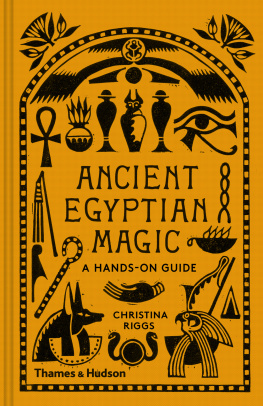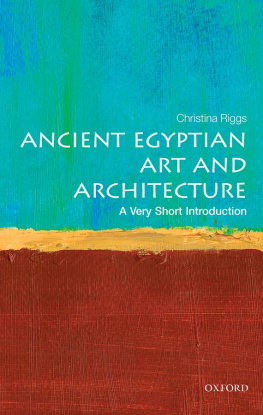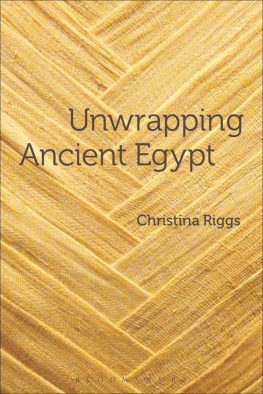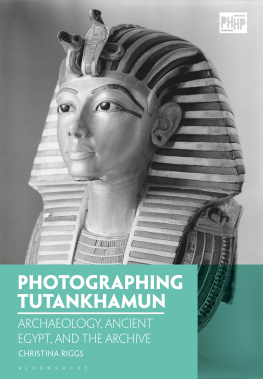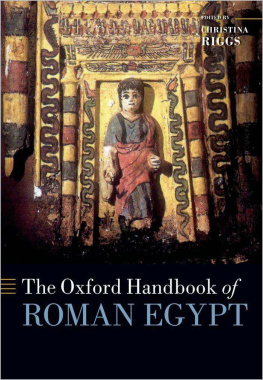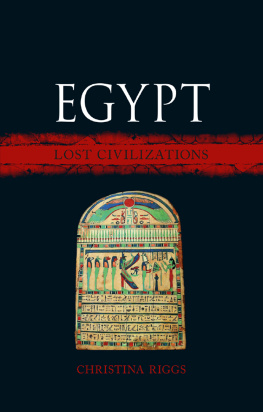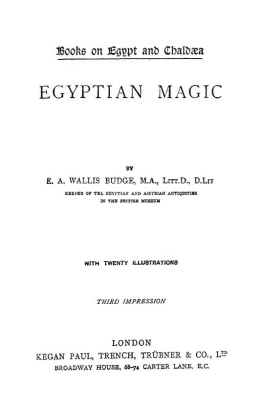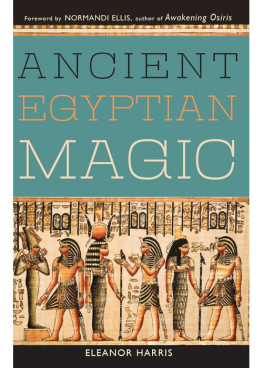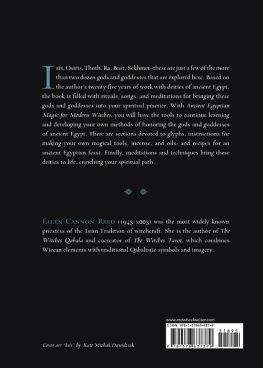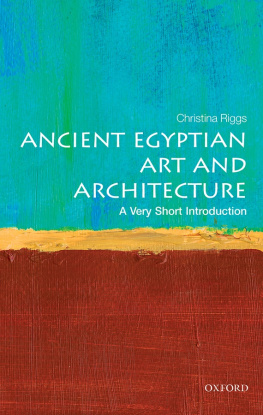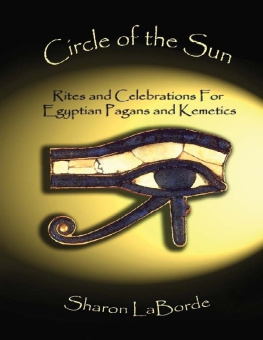Christina Riggs - Ancient Egyptian Magic
Here you can read online Christina Riggs - Ancient Egyptian Magic full text of the book (entire story) in english for free. Download pdf and epub, get meaning, cover and reviews about this ebook. year: 2020, publisher: Thames & Hudson, genre: Science fiction. Description of the work, (preface) as well as reviews are available. Best literature library LitArk.com created for fans of good reading and offers a wide selection of genres:
Romance novel
Science fiction
Adventure
Detective
Science
History
Home and family
Prose
Art
Politics
Computer
Non-fiction
Religion
Business
Children
Humor
Choose a favorite category and find really read worthwhile books. Enjoy immersion in the world of imagination, feel the emotions of the characters or learn something new for yourself, make an fascinating discovery.
- Book:Ancient Egyptian Magic
- Author:
- Publisher:Thames & Hudson
- Genre:
- Year:2020
- Rating:3 / 5
- Favourites:Add to favourites
- Your mark:
- 60
- 1
- 2
- 3
- 4
- 5
Ancient Egyptian Magic: summary, description and annotation
We offer to read an annotation, description, summary or preface (depends on what the author of the book "Ancient Egyptian Magic" wrote himself). If you haven't found the necessary information about the book — write in the comments, we will try to find it.
Ancient Egyptian Magic — read online for free the complete book (whole text) full work
Below is the text of the book, divided by pages. System saving the place of the last page read, allows you to conveniently read the book "Ancient Egyptian Magic" online for free, without having to search again every time where you left off. Put a bookmark, and you can go to the page where you finished reading at any time.
Font size:
Interval:
Bookmark:


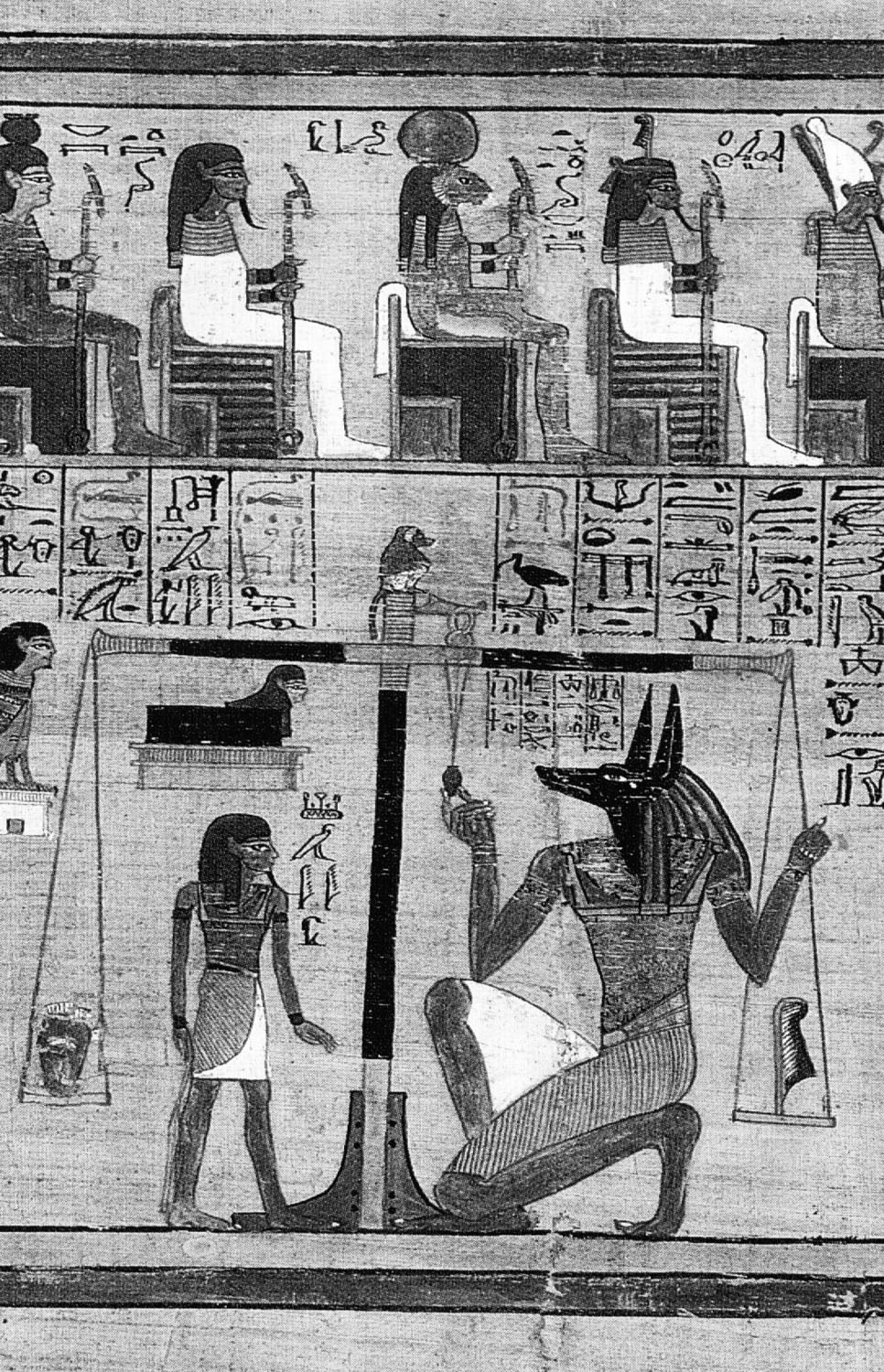

Christina Riggs is chair in the history of visual culture, Durham University, and a fellow of All Souls College, Oxford University. She is the author of six books, including Unwrapping Ancient Egypt (2014) and Ancient Egyptian Art and Architecture: A Very Short Introduction (2014).
Thames & Hudson include:
Ancient Magic
A Practitioners Guide to the Supernatural in Greece and Rome
Philip Matyszak
The Egyptian Myths
A Guide to the Ancient Gods and Legends
Garry J. Shaw
The Occult, Witchcraft and Magic
An Illustrated History
Christopher Dell
Be the first to know about our new releases, exclusive content and author events by visiting
www.thamesandhudson.com
www.thamesandhudsonusa.com
www.thamesandhudson.com.au
Sometime around 1650 BCE, in a tomb cut deep into the earth, an Egyptian magician was sent to the next life with the tools of his trade in this one: magic wands and figurines, and a box containing a bundle of reeds (spare pens) and his library of papyrus scrolls, in case he needed to check the exact wording of an incantation. Painted on the lid of the box was a hieroglyphic sign: a jackal stretched out on its belly, with its head high and ears alert. The sign meant secrets, perhaps labelling the contents of the box, or referring to the tomb-owners profession one of the titles given to Egyptian priests who specialized in reading, writing, and magic was master of secrets.
Magic permeated the everyday landscape of life in ancient Egypt, but core to magic is its secrecy. Magic has to be mysterious in order to work. Otherwise, anybody could do it, and clearly not everybody can. If that might seem to dash the hope of trying out some ancient Egyptian magic, dont worry. Thanks to discoveries like the magicians tomb, we have a pretty good idea of how magic worked in ancient Egypt and we can start to see why it mattered so much. The ancient Egyptians set great store by their magicians and the power of magic to make things happen. They had a word for magic heka and clear ideas about a magicians responsibility to use heka to help those who were unable to help themselves. Though thats not to say that magicians didnt get up to other tricks as well, as we know from ancient adventure stories telling tall tales of their exploits.
This book takes ancient Egyptian magic seriously by taking it on its own terms. Within these pages, youll find spells to ease labour pains and headaches, spells for becoming invisible, and spells requiring magic wands, voodoo-dolls (sort of), and an Abracadabra. Therell be tales of fantastic beasts, secret chambers, and trips to the underworld, as well as tips for predicting the future. There will be a pinch of salt here and there; after all, the salt compound natron was ancient Egypts best-performing detergent, and a crucial ingredient in mummy-making. Before we get carried away on a winged sun disk, though, lets first look in a little more detail at the magicians tomb, or whats left of it. That will help us understand what we mean when we talk about magic in ancient Egypt, and what the ancient Egyptians themselves thought magic could do and who could do magic.
When British archaeologists discovered the tomb shaft in the winter of 189596, they found that the two burial chambers at the bottom were empty of any inhabitant no coffin, no mummy, and no hint of the occupants name. The reuse of tombs at this time was common, and faithfully buried mummies often found themselves evicted in later years. Only the box of papyri and the objects found around it offered a clue to the original owners identity. The shaft has become known as the Ramesseum tomb, because about four hundred years after the burial, a temple now known by that name was built above it in honour of King Ramses II (13041213 BCE). But it is also sometimes known as the magicians tomb, because of the objects found within.
This 3,600-year-old magicians kit contained a fascinating array of specialist equipment: wands made from curved hippopotamus tusks, incised with turtles, baboons, long-necked lions with wings, and knife- and snake-wielding demons; a bronze wand in the shape of a rearing cobra; and small figurines, including a lion and several baboons, one of the animals sacred to Thoth, the god of writing. There were beads and amulets, a little cup shaped like a lotus flower, and miniature models of food, including a melon or squash and a bunch of grapes. Three figurines in the form of naked women, made without any lower legs and feet, may have raised Victorian eyebrows at the time of the discovery. Similarly strange was a wooden statuette representing a naked woman whose face has the features of a lioness. She holds a miniature metal snake in each hand, resembling some of the figures incised on the ivory wands.
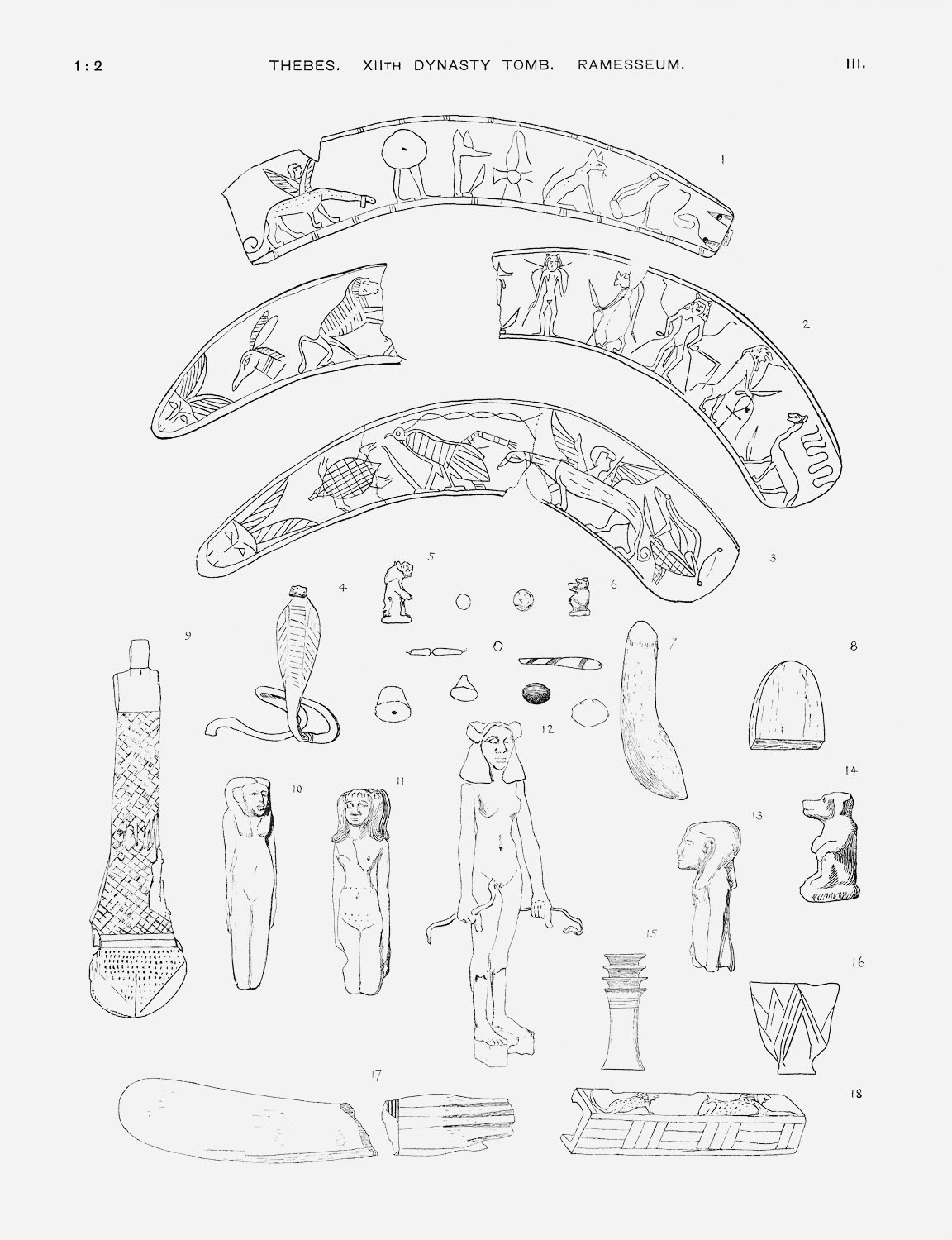
A magicians equipment? Line drawings of the magical objects found in a box in the Ramesseum tomb.
This collection of artefacts makes more sense the more scholars have studied similar material from around the same period, as well as the texts written on the scrolls found in the secret box. Many of the objects found in the Ramesseum tomb show signs of long use, wear, and repair. The wands had been broken and put back together in ancient times, and the wooden statuette with snakes in its hands had been adapted at least once, perhaps to fit a new plinth. Any or all of these objects may have been heirlooms, made more precious and powerful by being passed down from one magician to another, until finally the decision was made to inter them in the tomb. Perhaps there was no one left to inherit them, or perhaps this particular master of secrets wanted to take them with him. Who was going to argue with a magician, even after he was dead? Or especially after he was dead, since magic could even be used to move between this world and the next.
The box vanished at some point after the discovery, before the papyri and objects were divided between several museum collections in England, and the scrolls had been crushed, meaning that they have had to be painstakingly reconstructed from fragments. There are some secrets well never know. But there is quite a lot that we can piece together, like those fragmented scrolls. The papyrus was of the very best quality, and the texts were written in both hieroglyphic script and hieratic, a shorthand form of hieroglyphs that was easier and faster to use on papyrus. The box contained at least two dozen scrolls, representing a library built up over many years and perhaps handed down through generations, since, like many of the objects, some of the papyri had been reused and repaired over time. Among the many different texts written on them, there are hymns to the gods, ritual instructions for religious festivals, and classic works of Egyptian literature, including poems, adventure stories, and advice on living a good life. Magic spells predominate, though, from instructions for making amulets that can protect the body from harm to spells that call on the goddess Isis to help protect a house from any evil spirits that try to enter it. There are spells to ward off ghosts, snakes, and bad dreams; spells to drive away the demons that cause fever; and spells to guide a woman safely through childbirth and protect her newborn baby. Dealing with snakes, scorpions, and crocodiles was all in a days work, and thats before we get to the ghosts and demons. You might still be baffled, for now, about the figurines of naked women or baboons, but perhaps you can start to see why a magic wand, or three, could come in handy.
Next pageFont size:
Interval:
Bookmark:
Similar books «Ancient Egyptian Magic»
Look at similar books to Ancient Egyptian Magic. We have selected literature similar in name and meaning in the hope of providing readers with more options to find new, interesting, not yet read works.
Discussion, reviews of the book Ancient Egyptian Magic and just readers' own opinions. Leave your comments, write what you think about the work, its meaning or the main characters. Specify what exactly you liked and what you didn't like, and why you think so.

